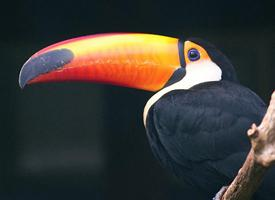
Greutăți și măsuri
| Lungime | de la 43 la 48 cm |
|---|
Descrierea animalului
The Collared Aracari (Pteroglossus torquatus) is a captivating bird species that belongs to the Ramphastidae family, which also includes the well-known toucans. This species is distinguished by its vibrant plumage, distinctive bill, and its social nature, making it a fascinating subject of study for ornithologists and a delightful sight for bird watchers.Physical Description:
The Collared Aracari boasts a striking appearance, characterized by its sizeable, curved bill that is as practical as it is colorful. The bill, a remarkable feature among toucans and their relatives, is predominantly yellow with a black tip and serrated edges, designed to peel fruit, its primary food source. The bird's body length varies from 41 to 46 cm, and despite its seemingly cumbersome bill, the Collared Aracari is quite agile.
Its plumage presents a vivid palette of colors. The bird's back, wings, and tail are primarily a deep, glossy black, which contrasts sharply with its bright yellow chest and cheeks. A notable feature is the red rump and the distinct collar for which it is named; a narrow band of red or chestnut feathers that separates the black plumage of its head from its yellow underparts. The skin around its eyes is blue, adding to its colorful visage, and its legs are grayish or greenish, blending subtly with its overall color scheme.
Habitat and Distribution:
The Collared Aracari is native to the tropical regions of Central and South America, ranging from southern Mexico through Panama, and extending into the northern parts of South America, including Colombia, Venezuela, and Ecuador. It favors humid lowland forests, often thriving at the forest edges, secondary forests, and plantations. The bird is typically found at elevations up to 1400 meters, though it is not commonly seen in mountainous regions.
Behavior and Diet:
This species is diurnal, active during the day, and is known for its social behavior. Collared Aracaris often travel in small flocks of up to 15 individuals, foraging for food and interacting with one another. Their diet is predominantly frugivorous, consisting mainly of various fruits, but they also consume insects, eggs, and small vertebrates, making them opportunistic feeders.
Collared Aracaris are cavity nesters, utilizing natural holes in trees or those excavated by other species. They exhibit cooperative breeding behavior, with several adults contributing to the care of the eggs and the young. This social structure is beneficial for the survival of the offspring, providing them with protection and an increased food supply.
Conservation Status:
Currently, the Collared Aracari is classified as Least Concern by the International Union for Conservation of Nature (IUCN). The species is relatively widespread and common within its range. However, like many tropical forest inhabitants, it faces threats from habitat destruction and fragmentation due to agricultural expansion and deforestation. Conservation efforts aimed at preserving its natural habitat are crucial for ensuring the continued survival of this remarkable species.
In conclusion, the Collared Aracari is a vibrant and intriguing bird, embodying the richness of tropical biodiversity. Its colorful appearance, social behavior, and ecological role make it an essential component of its habitat, contributing to the complex web of life in the tropical forests of the Americas.
Animale similare
Fotografii noi cu animale
Top 10 animale
- Diana monkey (Cercopithecus diana)
- Dolphin gull (Leucophaeus scoresbii)
- Galápagos tortoise (Geochelone nigra complex)
- Moustached guenon (Cercopithecus cephus)
- Japanese spider crab (Macrocheira kaempferi)
- Colossal squid (Mesonychoteuthis hamiltoni)
- Fox tapeworm (Echinococcus multilocularis)
- Stone loach (Barbatula barbatula)
- Japanese macaque (Macaca fuscata)
- Barbary macaque (Macaca sylvanus)

